The Swedish Speed Sailing Challenge
The outright sailing speed record is 49.09 knots, set by
Antoine Albeau
at
Saintes Maries de la Mer in southern France on 5th March 2008.
Video
of the record run. The previous record speed of 48.7 knots was set by
Finian Maynard
in April 2005.
After more than 10 years of attempts to increase record speed above 50
knots by several American, Australian and European projects, the
"50-knot barrier" has become the Holy Grail of speed-sailing. We are
planning to pass the 50-knot barrier with a revolutionary sailing craft and world-class
composite-construction technique.
Latest News
March-20-2007
The last year we have been sailing with our new wing-sail on Stora
Värtan
north of Stockholm. The advantage with this place is that the waves are
quite small, but the wind has usually been too low for record speed.
The new wing is an improvement, although it is smaller than the old one it
has enough power.
The advantage with the reduced sail area is that the wing is more robust,
easier to handle in strong wind, and handles wind-gusts better at high
speed.
We have also built a new paravane, designed for safe sailing speed up to 60
knots in high modulus carbon. The size is the same as for the old one, but
it is stiffer, and has some other small improvements in the design.
We tested the new paravane at record speed beside a 32 feet
Rupert RIB,
which was an excellent platform for such tests. Thanks to these
measurements
we were able to adjust the paravane so the drag was reduced by 20 %.
Our major problem seems to be that steady wind above 14 knots is unusual on
our present spot of water.
On one occasion e.g, we measured wind-gusts up to 30 knots, and the boat
accelerated like a rocket, but stopped abruptly at some 30+ knots because
the wind suddenly died. The good thing we learnt that day was that the boat
is very robust, and can handle much more wind than the 17 to 20 knots
required for record speed.
Now we have also built an 11 m plywood box where all components of the boat
and wingsail can be stowed and carried in a safe way. This will make it
possible to go and practise at places with more steady wind.
September-5-2006
Watch the latest video [7.9 Mb] from the high-speed tests in Stockholm.
June-20-2005
We are now building a new wing-sail with improved gust-characteristics. The new wingsail is built in carbon-fibre and NM-650 laminating epoxy from Epotex, which has long potlife and superior strength, on a low density foam core. We expect to be out sailing again later in the summer.
April-20-2005
The outright world sailing speed record has been beaten again on 10th April 2005 by Finian Maynard (BVI) at St Maries de la Mer in southern France. The new world record of 48.7 knots has been ratified by the WSSRC.
November-13-2004
The world speed sailing record has been beaten on 13th November 2004 by Finian Maynard in France. (subject to ratification by WSSRC). The new record of 46.82 knots is 0.3 knots over the previous one set by Yellow Pages Endeavour in October 1993.
September-19-2004
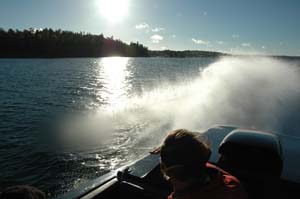 We have finished the testing of the Paravane at record
speeds. This was possible thanks to Roland Fredriksson who kindly helped
us
with his racing powerboat, which was an excellent tool for these tests,
where he used the trim-planes in a clever way to counteract the
side-force
from the Paravane. The trim of the Paravave have been
adjusted for optimum performance at record speeds.
We are now ready for speeds in the 40-50 knot range.
We have finished the testing of the Paravane at record
speeds. This was possible thanks to Roland Fredriksson who kindly helped
us
with his racing powerboat, which was an excellent tool for these tests,
where he used the trim-planes in a clever way to counteract the
side-force
from the Paravane. The trim of the Paravave have been
adjusted for optimum performance at record speeds.
We are now ready for speeds in the 40-50 knot range.
September-3-2004
 The Daily
Sail features an article about the Swedish Speed Sailing Challenge
The Daily
Sail features an article about the Swedish Speed Sailing Challenge
July-9-2004
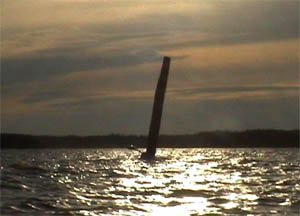 The sailing continues outside Stockholm. The boat shows
an impressive
performance and have proven a lot easier to sail than we
first expected. One minor problem is that the visibility for the
helmsman is rather poor,
but since it isn't possible to steer the boat anyway it hasn't
become a problem yet. Only a few incidents resulting in a capsize have
occured, all without any damage.
Quicktime movie showing the boat at 30-35 knots
with Alexander Sahlin pulling the sheet.
(Yes, we are looking for a larger motorboat to shoot
videos from.)
The sailing continues outside Stockholm. The boat shows
an impressive
performance and have proven a lot easier to sail than we
first expected. One minor problem is that the visibility for the
helmsman is rather poor,
but since it isn't possible to steer the boat anyway it hasn't
become a problem yet. Only a few incidents resulting in a capsize have
occured, all without any damage.
Quicktime movie showing the boat at 30-35 knots
with Alexander Sahlin pulling the sheet.
(Yes, we are looking for a larger motorboat to shoot
videos from.)
July-3-2004
 First sailing trials after the winter were very successful under sunny
skies with a gentle breeze of 7 m/s. We logged about 33.0 knots on
relatively rough
waters outside Stockholm. The sailing was smooth and stable and the
boat was easy to handle. Sheet in and hang on - kind of experience.
Have a look at a bumpy video (
quicktime
,
avi
)
and a few pictures .
The performance of the boat is
very promising to say the least.
We will step up the speed during the
next weeks.
First sailing trials after the winter were very successful under sunny
skies with a gentle breeze of 7 m/s. We logged about 33.0 knots on
relatively rough
waters outside Stockholm. The sailing was smooth and stable and the
boat was easy to handle. Sheet in and hang on - kind of experience.
Have a look at a bumpy video (
quicktime
,
avi
)
and a few pictures .
The performance of the boat is
very promising to say the least.
We will step up the speed during the
next weeks.
February-27-2004
Visit The Stockholm International Boat Show 2004, 27 February - 7 March 2004, and have a look at our speed boat in the innovation expo.
November-30-2003
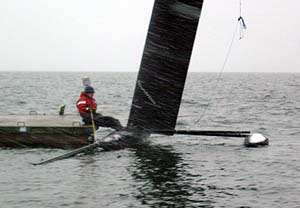
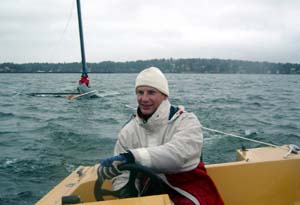 The test sailing of the new boat continues in Stockholm.
The weather have been unusually calm lately,
with winds of about 5 m/s. This is somewhat under what we need to
reach the high speeds the boat was designed for. We have mainly been
sailing just
above planing conditions with a few short high-speed
bursts during gusts. The advantage being that
we have had a lot of experience in handling the boat in conditions that
we could easily manage without damaging the boat.
The tests so far have given us many ideas on how to
improve the boat,
especially the handling characteristics at low speed where we have had
some
problems with the course stability before getting into planing mode.
The test sailing of the new boat continues in Stockholm.
The weather have been unusually calm lately,
with winds of about 5 m/s. This is somewhat under what we need to
reach the high speeds the boat was designed for. We have mainly been
sailing just
above planing conditions with a few short high-speed
bursts during gusts. The advantage being that
we have had a lot of experience in handling the boat in conditions that
we could easily manage without damaging the boat.
The tests so far have given us many ideas on how to
improve the boat,
especially the handling characteristics at low speed where we have had
some
problems with the course stability before getting into planing mode.
Pictures show Alexander preparing to leave the harbour before being towed out on the bay by Jens.
November-23-2003
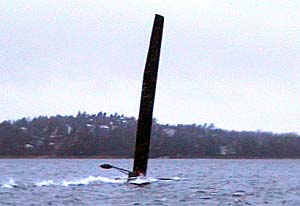 Today we made some highly successful runs at wind speeds around 5
m/s. Despite the terrible weather in Stockholm
now, with temperatures around 0 °C and only 4 °C in
the water and persistent snow fall all day.
We have overcome the control problems at low speed, that we had in
the beginning, and made the
transition into planing mode. The boat accelerates very quickly and is
completely stable at high speed, as our previous model and full
scale studies have shown. We will continue the testing this year
until it's no longer possible (ice).
Today we made some highly successful runs at wind speeds around 5
m/s. Despite the terrible weather in Stockholm
now, with temperatures around 0 °C and only 4 °C in
the water and persistent snow fall all day.
We have overcome the control problems at low speed, that we had in
the beginning, and made the
transition into planing mode. The boat accelerates very quickly and is
completely stable at high speed, as our previous model and full
scale studies have shown. We will continue the testing this year
until it's no longer possible (ice).
November-12-2003
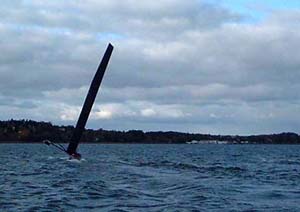 The last month we have done a lot of testing on the water, sailing as
well
as towing the boat and the paravane.
The sailing tests have confirmed that the boat is practical to handle
when
launching the paravane, when sailing and when towing backwards.
We have made a lot of minor adjustments on the paravane, on the lines
between the wing and paravane and on the bowsprit.
After a windward capsize during a start at too large true wind-angle we
are
very happy with our all carbonfibre wingsail and very rigid
wing-attachment,
that suffered no damage at all.
Now we are just waiting for 12 knots+ winds so we can start exploring the
speed-potential for the boat with proper tuning.
The last month we have done a lot of testing on the water, sailing as
well
as towing the boat and the paravane.
The sailing tests have confirmed that the boat is practical to handle
when
launching the paravane, when sailing and when towing backwards.
We have made a lot of minor adjustments on the paravane, on the lines
between the wing and paravane and on the bowsprit.
After a windward capsize during a start at too large true wind-angle we
are
very happy with our all carbonfibre wingsail and very rigid
wing-attachment,
that suffered no damage at all.
Now we are just waiting for 12 knots+ winds so we can start exploring the
speed-potential for the boat with proper tuning.
November-12-2003
Our speedsailer is featured on the last page of the swedish weakly technical newspaper Ny Teknik (no. 46, nov. 12, 2003). Read the article (in swedish) and have a look at the illustration.
October-12-2003
 First sailing trials today. Winds of 8-10 m/s stopped us from sailing
during the day but just before sunset the wind decreased to 2-4 m/s
so we launched the boat and pulled it out on the bay.
The wind was
not strong enough to lift the leeward hull but it was a start. The
light disappeared so we really don't have any good pictures.
First sailing trials today. Winds of 8-10 m/s stopped us from sailing
during the day but just before sunset the wind decreased to 2-4 m/s
so we launched the boat and pulled it out on the bay.
The wind was
not strong enough to lift the leeward hull but it was a start. The
light disappeared so we really don't have any good pictures.
October-10-2003
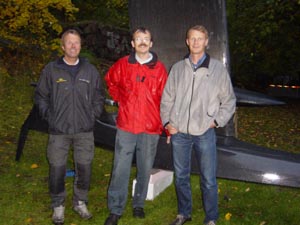 Roll-out. The speedsailer is now ready for sailing and was taken out of
the workshop today. The wingsail was mounted for the first time.
The Champagne was flowing (and the rain too) at this special event
that was witnessed by some twenty friends and supporters.
Göran, Alexander and
Jens is seen standing in front of the craft. Sailing begins shortly.
Roll-out. The speedsailer is now ready for sailing and was taken out of
the workshop today. The wingsail was mounted for the first time.
The Champagne was flowing (and the rain too) at this special event
that was witnessed by some twenty friends and supporters.
Göran, Alexander and
Jens is seen standing in front of the craft. Sailing begins shortly.
Sept-10-2003
 The hull is now ready for painting and instrumentation. The all-up
weight
excluding paint and instrumentation and crew is 101 kg. Silva are
supporting us with all instruments for the boat. The system will allow
us
to monitor all the relevant data during the runs with high accuracy.
The hull is now ready for painting and instrumentation. The all-up
weight
excluding paint and instrumentation and crew is 101 kg. Silva are
supporting us with all instruments for the boat. The system will allow
us
to monitor all the relevant data during the runs with high accuracy.
July-5-2003
The hull and deck was built in one piece, using the same technique as Sail-Center does for their A-cat hulls.
June-2003
A two-piece hull mold was built on the plug in carbon-fiber from Svenska Tanso and heat-resistant Araldite epoxy.
May-30-2003
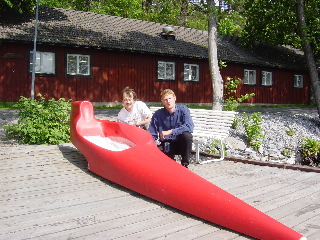 Alexander and Jens besides the male mold for the main hull that
was finished today. The female mold will
be made in carbon and epoxy allowing us to use the autoclave at
sail-center for the curing of the pre-preg nomex sandwich of the final
hull. The male mold was cut from blocks of styrofoam using a CNC
hot-wire
cutter at FOI
and then sanded and painted to finish.
Alexander and Jens besides the male mold for the main hull that
was finished today. The female mold will
be made in carbon and epoxy allowing us to use the autoclave at
sail-center for the curing of the pre-preg nomex sandwich of the final
hull. The male mold was cut from blocks of styrofoam using a CNC
hot-wire
cutter at FOI
and then sanded and painted to finish.
April-2003
Famous swedish powerboat designer Ocke Mannerfeldt was engaged to help with the hydrodynamic design of the planing hull.
March-10-2003
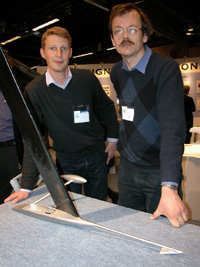 The wing-sail and a model of our craft is shown on Stockholm Boat Show
in at a section showing innovations for boating. A large interest was
generated by the 11 m long wing, weighing only 35 kg, cutting
off most of the exhibition area. Take part of the
information leaflet (in swedish)
that was handed out at the fair.
The wing-sail and a model of our craft is shown on Stockholm Boat Show
in at a section showing innovations for boating. A large interest was
generated by the 11 m long wing, weighing only 35 kg, cutting
off most of the exhibition area. Take part of the
information leaflet (in swedish)
that was handed out at the fair.
Sept-2002 to January-2003
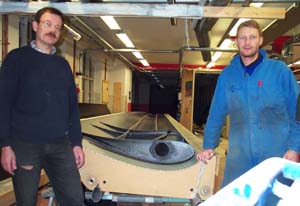 The wingsail was built in Sail-Centers facilities in Åtvidaberg.
11 m long with area 12.5 m^2. Total weight: 37 kg.
The wingsail was built in Sail-Centers facilities in Åtvidaberg.
11 m long with area 12.5 m^2. Total weight: 37 kg.
June to August-2002
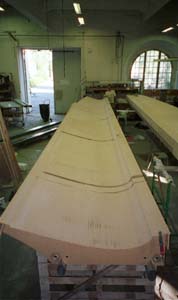 The moulds for the wing-sail was built.
The moulds for the wing-sail was built.
May-2002
Some high-precision moulds for paravane-components was built.
January-2002
The wing-section was redesigned to become more tolerant for turbulence and having a more gentle stall behavior.
November-2001
The wing-section for the sail was tested in a wind-tunnel at FOIfor evaluating the high-lift performance.
Sept-2001
Based on the results from the paravane tests on the M-20 and towing tests on the paravane we designed a 12.5 m^2 wing-sail one-tack paravane-stabilized boat with planing hull and planing ski on bowsprit.
Sept-10-2001
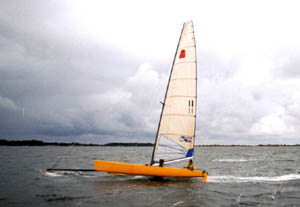 This weekend we have been evaluating the Paravane concept in
Loftahammar,
for the second time,
using a modified Marström M20 catamaran. The highest recorded
speed achieved
was about 29 knots measured by the GPS set at 10 seconds averaging. The
main source of drag seems to be the catamaran hull that is optimized for
substantially lower speeds. We are also are also having difficulties
with the rig that
is to soft for the forces generated by the high speeds. It is almost
impossible to sheet in hard enough at speed. The sheeting have to be
done
at standstill which is not very optimal.
This weekend we have been evaluating the Paravane concept in
Loftahammar,
for the second time,
using a modified Marström M20 catamaran. The highest recorded
speed achieved
was about 29 knots measured by the GPS set at 10 seconds averaging. The
main source of drag seems to be the catamaran hull that is optimized for
substantially lower speeds. We are also are also having difficulties
with the rig that
is to soft for the forces generated by the high speeds. It is almost
impossible to sheet in hard enough at speed. The sheeting have to be
done
at standstill which is not very optimal.
Summer-2001
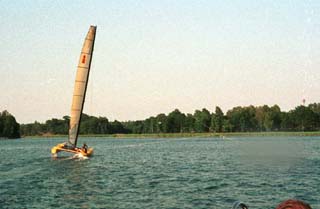 First test of the Paravane concept using a Marström M-20 catamaran. In the
light summer breeze we sailed up to 20 kn in the beautiful
harbour of Loftahammar.
First test of the Paravane concept using a Marström M-20 catamaran. In the
light summer breeze we sailed up to 20 kn in the beautiful
harbour of Loftahammar.
March to May-2001
A new paravane, optimized for speed around 50 knots was designed and built.
January-2001
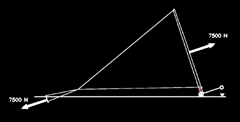 We contacted Göran Marström at Sail-Center, who was also very
keen on having
a shot at the 50-knot "barrier".
Now we had 3 of 4 necessary ingredients: 1) the concept of a sailing
craft
faster than anything on water. 2) A sound knowledge of fluid-dynamics. 3)
world-class composite construction techniques.
The 4:th ingredient, i.e. sponsorship was expected to become available
when
we got something to show on the water.
We contacted Göran Marström at Sail-Center, who was also very
keen on having
a shot at the 50-knot "barrier".
Now we had 3 of 4 necessary ingredients: 1) the concept of a sailing
craft
faster than anything on water. 2) A sound knowledge of fluid-dynamics. 3)
world-class composite construction techniques.
The 4:th ingredient, i.e. sponsorship was expected to become available
when
we got something to show on the water.
A novel craft using the Paravane to counteract the sail force to create a boat without a healing moment was designed. The 'Swedish Speed Sailing Challenge' was formed.
 www.marstrom.com
www.marstrom.com
 www.silva.se
www.silva.se www.ocke.se
www.ocke.se www.rupertmarine.com
www.rupertmarine.com www.kgksuzuki.se
www.kgksuzuki.se www.epotex.se
www.epotex.se www.hp.se
www.hp.se ni.com/sweden
ni.com/sweden www.vinova.se
www.vinova.se www.robship.se
www.robship.se